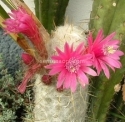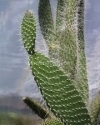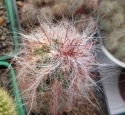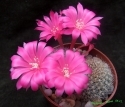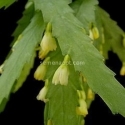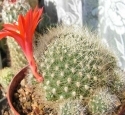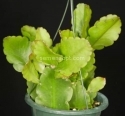
info@semenaopt.com
Directory
TOP 5 for 2025
| Root : fiber Shoots : dark green, round to ovate, 7.5 - 12.6 cm Grows : in the vast territories of the American continent from Patagonia to Canada, the second spread in almost all tropical andsubtropical regions of the world Motherland : from south-east to the far north USA Rod : Opuntia (Tournef . ) Mill . | Areola : First yellow, then become dark gray radial bristles 8 - 9, up to 15 mm Height : 1 m , Shoots : strong shoots up 10 cm in diameter, matted hair, thickly interwoven, often on top of the coffee color, on a stalk about ten edges 2.5 cm wide Motherland : the Andes, or the North to the South of Chile Peru Rod : Oreocereus (Berg . ) Ricc . | |
| Areola : convergence Height : 5 m to Shoots : from round to elongated, 10 - 20 cm , Grows : in the territoriesThe American continent from Patagonia to Canada, the second spread in almost all tropical and subtropical areas of the world , Motherland : Mexico (Durango) Rod : Opuntia (Tournef . ) Mill . | Areola : golden yellow, numerous, thick, greenish buds Height : 60 cm, sometimes stunted Spikes : no Shoots : up to 15 cm, round, pale green, soft , Grows : the vast territories of the American continent from Patagonia to Canada,secondary spread in almost all tropical and subtropical areas of the world Motherland : Northern Mexico , Rod : Opuntia (Tournef . ) Mill . | |
| Areola : Large, around the areola on the stem 10 - 17 ribs hair strands tangled, thick, occasionally brownish top, up to 5 cm Height : 1 m , Shoots : thickness of 8 - 12 cm Motherland : South of Bolivia to northern Argentina Rod : Oreocereus (Berg . ) Ricc . | Height : 5 m to Shoots : large, thick, round, sometimes slightly elongated, up to 25 cm, covered with a light bluish-green patina Grows : the vast territories of the American continent from Patagonia to Canada, the second spread in almost all tropical and subtropical areas of the world Motherland : Central Mexico Rod : Opuntia (Tournef . ) Mill . | |
| Height : 6 m to Spikes : up to 3 on the shoot rather short spikes Shoots : gray-green, elongated, length 10 - 12 cm, velvety to the touch , Grows : the vast territories of the American continent from Patagonia to Canada, secondary spread in almost all tropical and subtropical areas of the world Motherland : Mexico (mountain areas) Rod : Opuntia (Tournef . ) Mill . | Height : 7 cm low Spikes : 10 - 15 radial spines Shoots : thick on them 15 - 25 lower ribs hairs thick, thin, white, up to 7 cm Motherland : Northern Argentina (Humahuaca) Rod : Oreocereus (Berg . ) Ricc . | |
| Areola : small Height : 5 m to Shoots : long, fairly wide, and 50 cm , Grows : the vast territories of the American continent from Patagonia to Canada, secondary spread in almost all tropical and subtropical areas of the world Motherland : tropical and subtropical areas of America Rod : Opuntia (Tournef . ) Mill . | Height : 5 cm Flowers : small, grow from the lower areola, day, funnel-shaped Spikes : small spikes, to thin hair-like Motherland : Northern Argentina (Salta , Quebrada Eskoype) Rod : Rebutia K . Sch . , has 19 species with 21 species | |
| Areola : barely pubescent without bristles . The genus Hatiora areola are located at the ends of segments Spikes : absent, instead of them in a very small areolas sit fine hairs Shoots : up to 40 cm long and 3 - 5 cm wide, with notches on the edges, straight teeth, to 3 cm long and 1 cm wide Grows : with spectacular Ampelnii cultivation Motherland : Brazil (Rio de Zhapsyro, Sai Paulo Mina Geral-IS) Rod : Rhipsalis Gartn . | Spikes : absent, instead of them in a very small areolas sit fine hairs Shoots : soft, very thin, highly branched . End shoots a thickness of 2 - 3 mm, sometimes have mild four faces Grows : with spectacular Ampelnii growing Motherland : Forest East Brazil Rod : Rhipsalis Gartn . | |
| Height : 4.5 cm Flowers : small, grow from the bottom areola, day, funnel-shaped Spikes : 15 - 20 pieces, fine, thin hair-up Motherland : Northern Argentina (Salta) Rod : Rebutia K . Sch . , counts19 species with 21 species | Flowers : from Rebutia grandiflora are smaller flower and short tube . Refers to the slow-growing species Spikes : 20 - 25 pcs Motherland : Northern Argentina (Tucumán) Rod : Rebutia K . Sch . , has 19 species with 21 species | |
| Areola : Barely pubescent . The genus Hatiora areola are located at the ends of segments Shoots : beginning with erect, later - drooping shoots up to 1 m, shoots elliptical to round, with prominent veins, dark green, edges and purple veins Grows : with spectacular Ampelnii growing Motherland : Brazil (from Santa Catarina to Rio de Janeiro, São Paulo to Sierra Kantareyro) Rod : Rhipsalis Gartn . | Areola : located close to each other . The genus Hatiora areola are located at the ends of segments Shoots : at the end of the barrel apart with a fork, have 4 - 5 faces lengthshoots 1 - 2.5 cm, a thickness of 4 mm, terminal shoots are thinner at the base rounded, reddish Grows : with spectacular Ampelnii growing Motherland : Brazil , Rod : Rhipsalis Gartn . | |
| Height : 8 cm Flowers : in the form of grafted plants well bushes and give more flowers Spikes : small thin hairlike up, numerous bristles, about 25 pieces Motherland : Northern Argentina (Salta top Quebrada Eskoype) Rod : Rebutia K . Sch . , has 19 species with 21 species | Areola : Covered with gray felt, sometimes have 1 - 2 dark bristles . The genus Hatiora areola are located at the ends of segments Spikes : absent, instead of them in a very small areolas sit fine hairs Shoots : unit, or alternately grow beams cylindrical length of 50 cm and a thickness of 5 mm Grows : with spectacular Ampelnii growing Motherland : Brazil (Sao Paulo, Mi-us Gerais , Rio de Janeiro) Rod : Rhipsalis Gartn . | |
| Areola : first covered with hairs Shoots : blue-green Motherland : South Mexico , Rod : Peireskiopsis Br . et R, subfamily Opuntioideae | Areola : Pressed into the stem Root : the root system is weak, many species require vaccinations Spikes : no Shoots : elongated rounded Motherland : West Argentina (Mendoza) Rod : Tephrocactus Lem . |
Rod
acanthocalycium backbg .
aporocactus lem
astrophytum lem .
austrocylindropuntia backbg
aylostera speg .
brasilicactus backbg .
brasiliopuntia (k . sch . ) berg .
cephalocerciis pfeiff .
cereus mill .
cleistocactus lem .
cliamaecereus br . et r .
copiapoa br . et r .
coryphantha (eng . ) lem .
dolichothele (k . sch . ) br . et r
echinocactus lk . et o .
echinocereus eng .
echinofossulocactus lawr .
echinopsis zucc .
epiphiliopsis berg .
epiphillum haw .
eriocactiis backbg .
eriocereus (berg . ) ricc .
espostoa br . et r .
ferocactus br . et r .
frailea br . ef r .
gymnocaclus backbg .
gymnocalycium pfeiff .
hamatocactus br . et r
hatiora br . et r .
helianthocereus backbg .
heliocereus (berg . ) br . et r .
horridocactus backbg .
hylocereus br . et r .
lepismium
lobivia br . et r .
loxanthocereus backbg .
mammillaria haw
matucana br . et r .
mila br . et r .
myrtillocactus cons .
neochilenia backbg .
neoporteria br . et r .
notocactus (k . sch . ) berg .
opuntia (tournef . ) mill .
oreocereus (berg . ) ricc .
parodla speg .
peireskia (plum . )
peireskiopsis br . et r
pseudolobivia backbg .
rebutia k . sch .
rhipsalis gartn .
selenicereus (berg . ) br . et r
tephrocactus lem .
trichocereus (berg . ) ricc .
weingartia word .
zygocactus k . sch .

